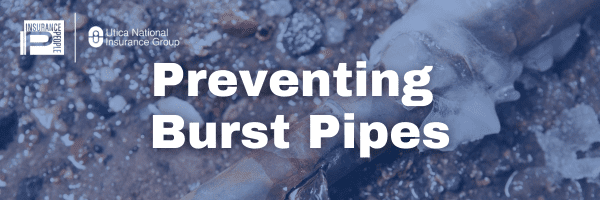We hope that everyone had a wonderful time with their friends and families over the holidays. As we enter 2024, we want to make sure everyone has prepared their homes for the winter. Our friends at Utica National provided us with some information regarding how to prevent pipes from bursting. Below, you will find the information from Utica:
Many people believe that when water freezes in a pipe, the ice expands, pushing against the walls of the pipe causing a pipe to burst. In reality, this is not the case. Freezing water pipes do not burst directly from the physical pressure of ice growth, but from excessive water pressure. The fact that water is freezing within a pipe does not, by itself, endanger the pipe. Usually, the pipe bursts where there is little or no ice formation. When a pipe outlet is still open, ice growth exerts no pressure on the pipe because the volumetric expansion is absorbed by the entire water system. A pipe that is open on one end cannot be pressurized and will not burst.
Water has to freeze for ice blockages to occur. Pipes inside a building should be protected by placement within the building’s insulation, insulation on the pipe itself, or by heating. Vulnerable pipes that are exposed to subfreezing temperatures should be fitted with insulation sleeves and wrapping. The more the pipe is insulated, the better the protection.
It should be noted that a burst water pipe does not necessarily result in the immediate flooding of a building. A rupture may be initially sealed by the ice blockage. A flooding condition will occur when the ice blockage thaws out and the burst location is under flow conditions.
Freezing
Pipes typically burst at locations where freezing last occurs. Thus, an insulated portion of an otherwise poorly insulated pipe is likely to be the place where the pipe breaks.
When water freezes, it expands. While the expansion of water as it freezes is the underlying cause of a pipe bursting, the actual deformation or breakage of the pipe results from a secondary consequence of the expansion – namely, hydraulic pressure in that part of the water last to freeze.
To demonstrate this event, take a water-filled metal bucket and set it on a block of Styrofoam and let it freeze. What results is that the bucket will have a bulge at the bottom. This phenomenon is due to the hydraulic pressure in the last water to freeze, in this case, at the bottom of the bucket. Yet, if the Styrofoam is placed on the top of the bucket, no bulging occurs because the last water to freeze is near the top surface where there is no metal to be bent.
If you wrap insulation around short sections of an otherwise exposed pipe filled with water, the pipe will burst under the insulation and the water will leak into the insulation, proving that liquid water was still present at the time of the breakage.
As the last of the water freezes in the pipe, the increasing hydraulic pressure causes the melting point of the confined ice to decrease. By the time the pressure rises to 8,000 psi (551.6 bar), the melting point will be lowered to almost 23°F (-5°C). If that pressure is not enough to break the pipe, at -6°F (-21°C), the pressure will build to 28,000 psi (1,931.0 bar).
Piping Considerations
Commonly used water pipes in construction are made of copper, black iron, or PVC (polyvinyl chloride). Plastic pipes have both thicker walls and greater resistance to heat flow. Copper pipes in turn have virtually no resistance to heat flow. However, only in marginal cases would the added thermal resistance of plastic pipes prevent annular ice blockage in comparison to copper pipes.
The determination of the pipe diameter in a plumbing system is based on necessary service demands and flow requirements. For these reasons, an attempt to reduce burst pipe incidents through the specification of different pipe diameters is of very little value.
Another common thought is that, when subjected to identical conditions, a hot-water pipe will burst before a cold-water pipe. A definitive, widely accepted explanation has yet to be given. One theory holds that premature bursting is a result of greater dendritic ice formation in hot-water pipes as compared to cold-water pipes. However, when water pipes begin to cool toward identical temperatures, it makes no difference if the water was drawn from a cold- or hot-water source because the freezing process is identical. Usually, the difference between the freezing of a cold-water pipe and a hot-water pipe (both being of the same material and diameter) is approximately ten minutes. If hot-water pipes tend to burst before cold-water pipes, it is not due to the water’s response to the subfreezing temperature; more likely, it is due to the distribution of entrapped air in water systems because of the water heating process when temperatures rise and pressure increases.
The temperatures that water pipes are exposed to in a building is a function of the outside temperature, the interior building temperature, the building insulation near the pipe, and the pipe’s placement in a building cavity.
Pipes in attics, crawl spaces, and outside walls are all vulnerable to freezing, especially if there are cracks or openings that allow cold, outside air to flow across the pipes. “Wind chill,” the cooling effect of air and wind, can play a major role in accelerating freezing and bursting of water pipes. Holes or openings in an outside wall where cables, television wires, or telephone lines enter provide access for cold air.
Although 20°F (-6.7°C) is well below the freezing temperature of water, the temperature of an unheated portion of a building is almost always at least a few degrees above the outdoor temperature.
There are several precautions building owners should take when the temperature is expected to dip around 20°F (-6.7°C), including:
- Seal all openings where cold air can get at unprotected water pipes. It is especially important to keep cold wind away from pipes, which speeds up the freezing process.
- Cover pipes with foam sleeves or fiberglass insulation, a minimum of 2 in (5.08 cm), the thicker the better.
- Remove and store exterior hoses inside during cold weather.
- Leave interior doors open to allow warmer room air to circulate.
- Let faucets drip slowly to keep water flowing through pipes that are vulnerable to freezing. Ice might still form in the pipes, but an open faucet allows water to escape before the pressure builds to where a pipe can burst. If the dripping stops, it may mean that ice is blocking the pipe; keeping the faucet open will provide pressure relief in the pipe.
- Protect pipes in attics and crawl spaces with insulation or heat. Pipe insulation is available in fiberglass or foam sleeves.
- Close the main water shutoff value and leave open the various outlets. This will drain most of the water out of the system, introduce large quantities of air, and eliminate the possibility of bursting pipes during severe overnight temperatures.
- Use heating cables and tapes, which are effective for freeze protection. Select a high-quality heating cable with heavy wire insulation that is listed by a nationally recognized testing laboratory, such as Underwriters Laboratories Inc, and which has a built-in thermostat that turns the heat on when needed (without a thermostat, the cable has to be plugged in each time and might be forgotten). Follow the manufacturer’s instructions closely during installation. Heat tapes and cables will not work during power outages.
- Loss Prevention Strategies
There are four basic strategies for preventing burst water pipes:
- Pipe Placement
- Pipe Insulation
- Air Chambers
- Install pressure-relief plumbing fixtures to provide protection
Pipe Placement
Pipe placement prevents water pipes from ever encountering freezing temperatures through placement in the conditioned space of a building. Placement is meant to include the avoidance of air leakage through the building. This strategy is designed to prevent water pipes from encountering subfreezing temperatures and any potential for freezing and subsequent bursting.
Pipe Insulation
Pipe insulation provides sufficient pipe insulation to reduce heat loss to the point where freezing cannot occur. This strategy is designed to prevent or substantially delay the formation of an ice blockage and, in so doing, prevent the excessive pressures that lead to bursting.
Air Chambers
Air chambers are presently manufactured as “water hammer arrestors.” These devices are intended to address the problem of water hammer, which is the pressure-induced knocking of water pipes. Testing of these devices is designed to evaluate their endurance during numerous, momentary pressure surges. For burst protection, it would be necessary to determine the viability of these products under sustained pressure of 12 to 24 hours as compared with numerous pressure surges. It is possible that existing designs can meet the requirements for burst protection devices.
The use of air chambers on water pipes that run through unconditioned spaces could greatly reduce the incidence of burst water pipes. Economical air chambers that could be easily retrofitted to existing plumbing systems would be beneficial in addressing the existing risk exposure.
Where both subfreezing temperatures and ice blockage may occur, air chambers could be installed to moderate the excessive pressures required for bursting. This strategy allows total freezing and the temporary loss of water service but can help prevent losses by relieving the pressure that leads to bursting.
Pressure-Relief Plumbing Fixtures
Pressure-relief plumbing fixtures, as with air chambers, accept the completion of an ice blockage, but provides pressure relief. Rather than providing a chamber of air, pressure-relief-plumbing fixtures would discharge water from the line at a specified pressure well below the burst pressure of the line. Discharge would be through a fixture into the existing drain basin, for example, the sink or bathtub.
Widespread adaptation of pressure-relief plumbing fixtures could virtually eliminate the burst water pipes at marginally additional cost. They would require no maintenance and no more labor than to install a standard fixture.
Responding to Frozen Pipes
If a frozen pipe (open faucet, no water comes out) is suspected, a qualified plumber should be called. If a pipe bursts, the main valve should be shut off and the faucets left open until repairs are complete. Thawing a frozen pipe with an open flame or hair dryer should never be attempted.
If you have any questions about the workers compensation process, please contact the Insurance People team at evan@inspeople.com.

